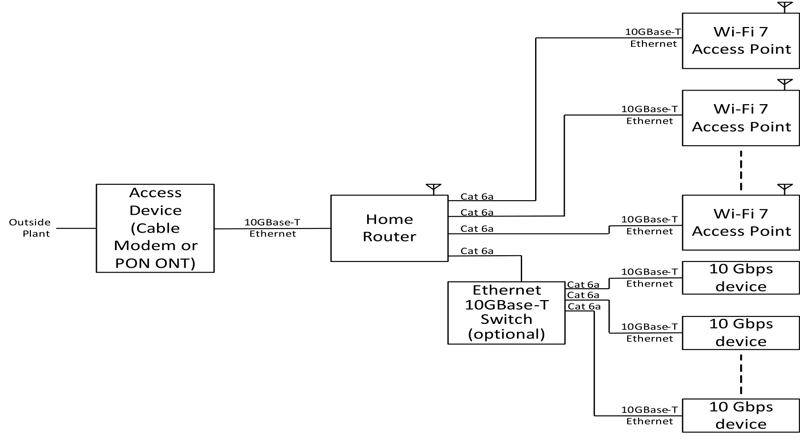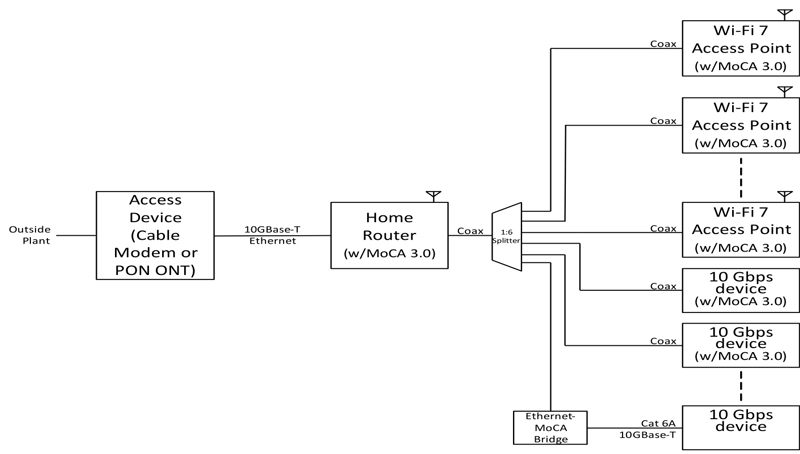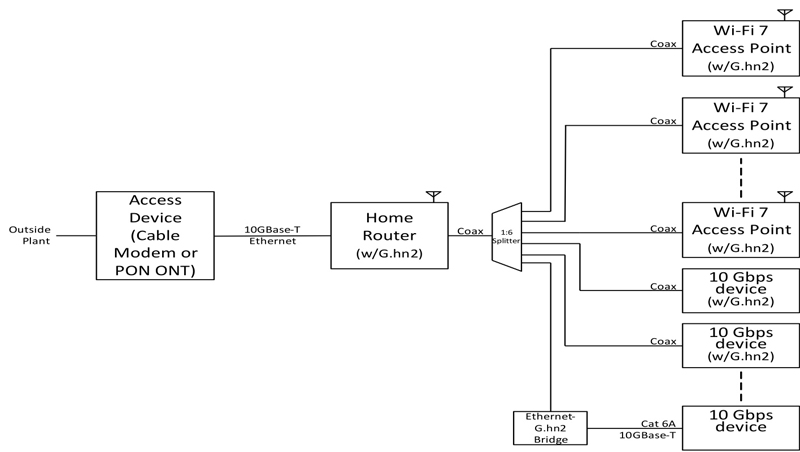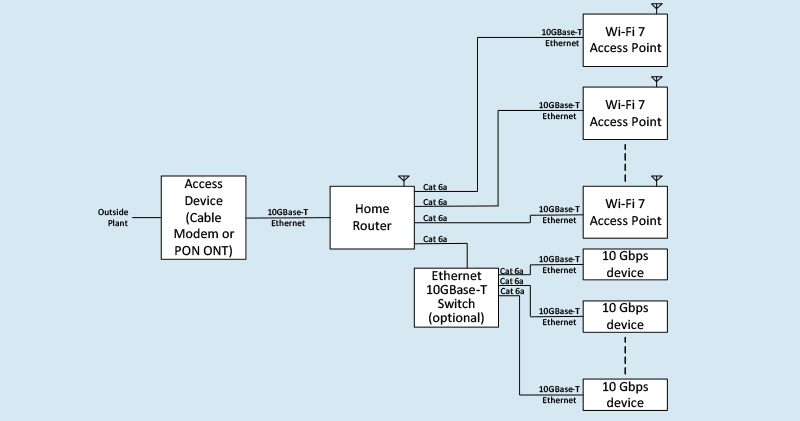A Preview of 10G Enabling Technologies
By Kinney Bacon
In 2019, the cable industry announced the 10G Initiative to bring 10 Gbps into customers’ homes. Once it gets to customers’ homes, how will it be distributed throughout the home? This article covers four of the technologies which are capable of delivering 10 Gbps within a customer’s home. Note that most of the technologies called out in this article are not currently available but are anticipated to be available when 10G is available to a home customer.
10G data delivery candidates
There are four candidates covered in this article that can meet 10 Gbps in a consumer home environment:
- Ethernet 10GBase-T
- MoCA 3.0
- hn2 (coax)
- Wi-Fi 7
For 10G delivery within the home, it is suggested that Ethernet 10GBase-T, MoCA 3.0, or G.hn2 (coax) be used for hardwire delivery of the 10 Gbps data within the home to Wi-Fi 7 access points (APs).
The Ethernet 10GBase-T implementation is based on the IEEE 802.3an standard. It utilizes Cat 6 cable for runs up to 55 meters and Cat 6a for runs up to 100 meters. Ethernet utilizes a point-to-point connection which can require an Ethernet switch for multipoint deployments.
The MoCA 3.0 specification was developed by the Multimedia over Coax Alliance (MoCA). MoCA 3 is capable of delivering 10 Gbps over common coaxial cable (e.g., Series 6). It utilizes mesh technology, supports encryption on the cable, and supports distances up to 100 meters.
The G.hn2 specification was developed by the International Telecommunication Union (ITU). The physical layer is capable of supporting 10 Gbps over coax. It utilizes mesh technology, supports encryption on the cable, and supports distances up to 100 meters.
Wi-Fi 7 is based on the IEEE 802.11be, currently under development. It utilizes the 2.4 GHz, 5 GHz, and 6 GHz ISM bands with a channel size of up to 320 MHz and modulation up to 4096-QAM OFDMA.
Home architecture overview
Based on the premise that the requirement is to deliver 10 Gbps with Wi-Fi throughout the entire home, a proposed architecture is to hardwire connections from the access device (either HFC or fiber) to the Wi-Fi 7 APs. These hardwire connections would be either Ethernet 10GBase-T, MoCA 3, or G.hn2.
Ethernet 10GBase-T
Ethernet 10GBase-T is a well understood technology with multiple suppliers. It is compatible with other Ethernet technologies so it can be deployed at this time. Generally, home routers have multiple Ethernet ports, however, if there are not enough ports available to reach devices, such as Wi-Fi APs throughout the home, then an Ethernet switch will be required (of course, it has to be 10GBase-T compatible).
The biggest issue for cable operators with regards to Ethernet is that the home must be wired with the appropriate cables, Cat 6a. Most homes in the USA are not wired for Ethernet, and if they are, many are wired with Cat 5 cable. Converting from coax or Cat 5 to Cat 6a will lead to a high operational cost of initial installation of the 10G service.
MoCA 3.0
The MoCA 3.0 specification is released but is not currently available in silicon. However, it is expected that silicon will be available in the future when 10G is deployed to homes. MoCA 3.0 supports up to 10 Gbps over coax. Note that in order to achieve 10 Gbps, the entire coax RF spectrum is utilized so therefore the coax cannot be used with any other signals. If less than 10 Gbps is utilized, then the RF spectrum could be shared. For example, the current MoCA 2.5 Gbps devices utilize frequencies above 1 GHz to achieve 2.5 Gbps, thereby allowing normal cable signals below 1 GHz.
The advantage for cable operators is that it can work on existing wired coax so no rewiring is required, thereby greatly reducing installation costs. Additionally, it is backwards compatible with MoCA 2.0 and MoCA 2.5, so it can be deployed prior to 10G availability in the outside plant.
One major advantage of MoCA over Ethernet is that the data carried on the cable can be encrypted. A network specific password is required, however, with the advent of the MoCA self-install mechanism, the network password can automatically be downloaded onto a new device once it has been authenticated, with no manual intervention. When this mechanism is utilized, it will allow self-installation of MoCA-based devices.
The primary disadvantage with MoCA is that unless it is built into a device, it will require a separate MoCA-Ethernet bridge unit.
Due to the isolation requirements for MoCA and DOCSIS to minimize interference, a two-box solution is preferred for HFC. This separates the home network from the outside plant. Additionally, this allows for the same home network architecture regardless of whether HFC or fiber is used for the access to the home.
G.hn2 (Coax)
The G.hn2 specification is released but is not currently available in silicon. However, it is expected that silicon will be available in the future when 10G is deployed to homes. G.hn2 supports up to 10 Gbps over coax. Note that in order to achieve 10 Gbps, the entire coax RF spectrum is utilized so therefore the coax cannot be used with any other signals.
The advantage for cable operators is the same as for MoCA, that is, it can work on existing wired coax so no rewiring is required. Additionally, same as MoCA, the data can be encrypted.
G.hn2 also shares the same disadvantage in that unless it is built into a device, then a separate G.hn2-Ethernet bridge unit will be required.
As with MoCA, the same isolation requirements exist for G.hn2 and DOCSIS. In order to minimize interference, a two-box solution is preferred for HFC. As with MoCA, this separates the home network from the outside plant. Additionally, this allows for the same home network architecture regardless of whether HFC or fiber is used for the access to the home.
Wi-Fi 7
The final connection to devices in the home is typically Wi-Fi. Wi-Fi 7 is currently under development as IEEE 802.11be and the specification should be ready by 2024. It will provide up to 46 Gbps under ideal conditions, including a 320 MHz channel. It is backwards compatible with Wi-Fi 6 and Wi-Fi 5.
Wi-Fi 7 will still have the same issues as other Wi-Fi technologies when delivering through a home environment. It is doubtful that Wi-Fi 7 can carry 10 Gbps throughout most homes with a single access point. Therefore, multiple access points will be required to meet the 10 Gbps rate throughout the home. The optimum Wi-Fi performance is to have multiple access points that are connected with a 10 Gbps capable hardwire backbone, in this case either Ethernet, MoCA, or G.hn2.
Wi-Fi 7 will be utilizing WPA3 for encrypting the signals. Therefore, the connection of devices to the Wi-Fi network will not change from current mechanisms.
Summary
Cable operators need to start thinking about how they will distribute the 10 Gbps signal through the home network once 10 Gbps technology is available and offered as a service. If they desire to use Ethernet, then the use of coax in homes should be switched over to Ethernet. If they desire to utilize the existing wiring and continue to use coax, then they need to plan on utilizing MoCA 3.0 or G.hn2, and to start deploying it as soon as the desired technology is available. When Wi-Fi 7 is used for communication, multiple APs will be required to provide the desired speeds throughout the premises. With enough foresight and planning, this can be accomplished such that customers will be happy with the 10G data service.

Figure 1. 10 Gbps Ethernet home network example

Figure 2. 10G home network MoCA 3.0 example

Figure 3. 10G home network G.hn2 example
References:
1 https://www.ncta.com/media/media-room/introducing-10g
2 http://www.mocalliance.org/
3 https://www.itu.int/

Kinney Bacon, PE,
Principal Engineer
Premises Technology,
Cox Communications, Inc.
Kinney is a Principal Engineer at Cox Communications in the Premises Technology group in Engineering, specializing in strategic architecture for devices and networks in the home or small business. Kinney has been in the cable industry since 1983 working for Scientific-Atlanta, Cisco, Comcast, and Cox Communications. His expertise is in embedded programming, ASIC design, digital circuit design, automated testing, client architecture and system architecture. He is the current chairman of the SCTE IoT Working Group and has been the co-chair of the ATIS IPTV Metadata Working Group. Kinney is a frequent contributor to CableLabs, SCTE•ISBE, CTA, and ATIS. Kinney is an avid cyclist currently living with his wife and two cats in Lawrenceville, GA. He is a graduate of the Georgia Institute of Technology.




